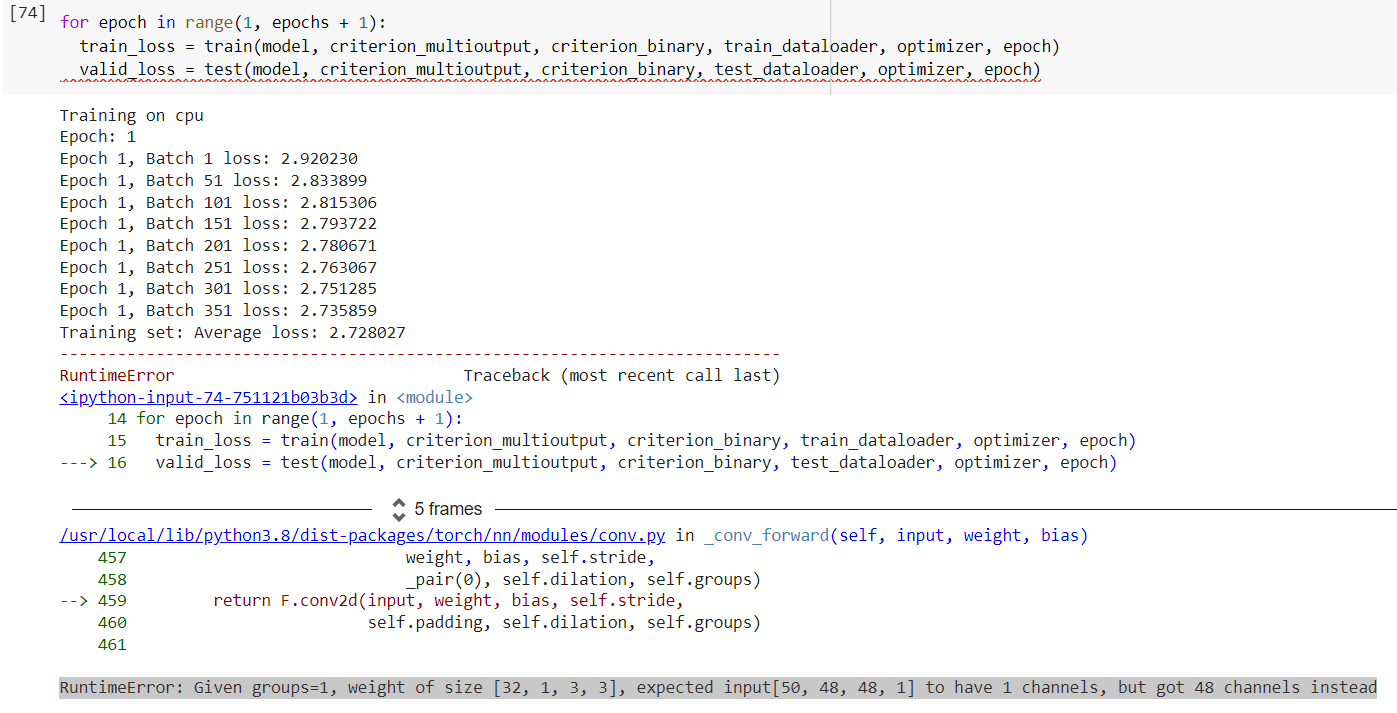I am facing this problem at the time of testing. While training the data it works fine, but at the time of testing the data it arise this error.
‘’’
class test_dataset(Dataset):
def init(self, age_label_test, gen_label_test, img_test):
self.age_label_test = np.array(age_label_test)
self.gen_label_test = np.array(gen_label_test)
self.img_test = np.array(img_test)
def len(self):
return len(self.img_test)
def getitem(self, index):
age_label_test = self.age_label_test[index]
gen_label_test = self.gen_label_test[index]
img_test = self.img_test[index].reshape(48,48,1)
#img = self.transform(X_train)
return img_test, age_label_test, gen_label_test
test_data = test_dataset(y_age_test[:], y_gender_test[:],
X_test[:])
test_dataloader = DataLoader(test_data, batch_size = 50, shuffle = True)
‘’’
‘’’
import torch.nn as nn
from torchsummary import summary
import timm
from timm.models.layers.classifier import ClassifierHead
import torch.nn.functional as F
Building Model
class Net(nn.Module):
def init(self):
super(Net, self).init()
self.conv1 = nn.Conv2d(in_channels = 1, out_channels = 32, kernel_size = 3, padding=1, stride=1)
self.relu = nn.ReLU()
self.maxpool = nn.MaxPool2d(kernel_size = 2)
self.conv2 = nn.Conv2d(in_channels = 32, out_channels = 64, kernel_size = 3, padding=1, stride=1)
self.conv3 = nn.Conv2d(in_channels = 64, out_channels = 128, kernel_size = 3, padding=1, stride=1)
self.conv4 = nn.Conv2d(in_channels = 128, out_channels = 256, kernel_size = 3, padding=1, stride=1)
#nn.Flatten()
self.fc1 = nn.Linear(in_features = 256*3*3, out_features = 1152)
self.fc2 = nn.Linear(in_features = 1152, out_features = 512)
self.linear1 = nn.Linear(in_features = 512, out_features = age_features) # For age class output
self.linear2 = nn.Linear(in_features = 512, out_features = gen_features) # For gender class output
def forward(self, x):
out = self.conv1(x)
out = self.relu(out)
out = self.maxpool(out)
out = self.conv2(out)
out = self.relu(out)
out = self.maxpool(out)
out = self.conv3(out)
out = self.relu(out)
out = self.maxpool(out)
out = self.conv4(out)
out = self.relu(out)
out = self.maxpool(out)
#print(out.shape)
out = out.view(x.size(0),-1)
out = F.relu(self.fc1(out))
out = F.relu(self.fc2(out))
label1 = self.linear1(out) # Age output
label2 = self.linear2(out) # Gender output
return {'label1': torch.softmax(label1,dim=1), 'label2': label2}
‘’’
‘’’
age_accuracy_list =
gender_accuracy_list =
validation_loss_list=
def test(model, criterion1, criterion2, test_dataloader, optimizer, epoch):
Switch the model to evaluation mode
model.eval()
correct_1 = 0
correct_2 = 0
total_1 = 0
total_2 = 0
valid_loss = 0
with torch.no_grad():
for batch_idx, (data, target1, target2) in enumerate(test_dataloader):
data, target1, target2 = data.to(device), target1.to(device), target2.to(device)
data = data.requires_grad_() # Load images(for accuracy)
output = model(data.float())
_, predicted1 = torch.max(output['label1'], 1)
_, predicted2 = torch.max(output['label2'], 1)
label1_hat = output['label1']
label2_hat = output['label2']
total_1 += target1.size(0)
total_2 += target2.size(0)
correct_1 += torch.sum(predicted1 == target1).item()
correct_2 += torch.sum(predicted2 == target2).item()
age_accuracy = 100 * correct_1 // total_1
gender_accuracy = 100 * correct_2 // total_2
# calculate loss
loss1 = criterion1(label1_hat, target1)
loss2 = criterion2(label2_hat, target2)
loss = loss1+loss2
valid_loss = valid_loss + ((1 / (batch_idx + 1)) * (loss.data - valid_loss))
print('Epoch: {} \tTraining Loss: {:.6f} \tValidation Loss: {:.6f} \tAge_Accuracy: {} \tGender_Accuracy: {}'.format(
epoch, train_loss, valid_loss, age_accuracy, gender_accuracy))
age_accuracy_list.append(age_accuracy)
gender_accuracy_list.append(gender_accuracy)
validation_loss_list.append(valid_loss)
return valid_loss, age_accuracy, gender_accuracy
‘’’
